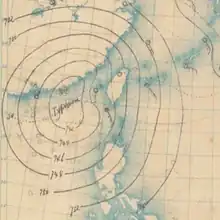1922 Shantou typhoon
The 1922 Shantou Typhoon was a devastating tropical cyclone that caused thousands of deaths in the Chinese city of Shantou in August 1922. This total makes it one of the deadliest known typhoons in history.
 | |
| Meteorological history | |
|---|---|
| Formed | July 27, 1922 |
| Dissipated | August 3, 1922 |
| Very strong typhoon | |
| 10-minute sustained (JMA) | |
| Highest winds | 155 km/h (100 mph) |
| Lowest pressure | ≤932 hPa (mbar); ≤27.52 inHg |
| Overall effects | |
| Fatalities | 50,000–100,000+ |
| Areas affected | Northern Philippines, China |
Part of the 1922 Pacific typhoon season | |
Meteorological history

A tropical depression located near the Caroline Islands was first spotted July 27. It moved slowly to the northwest, gradually intensifying along the Philippine Sea. On July 31, it crossed northern Luzon,[1] and entered the northernmost part of the South China Sea.[2] It then intensified more and made landfall on the Chinese coast near the city of Shantou (formerly romanized as Swatow) late on August 2 or early on August 3.[1] It quickly dissipated inland later.
The minimum known central pressure of this typhoon is 27.53 inches of mercury (932 mb).[3] At one point, the winds were estimated to have a speed exceeding 100 mph.[4]
Impact
| Rank | Typhoon | Season | Fatalities | Ref. |
|---|---|---|---|---|
| 1 | Nina | 1975 | 229,000 | [5] |
| 2 | July 1780 Typhoon | 1780 | 100,000 | [6] |
| 3 | July 1862 Typhoon | 1862 | 80,000 | [7] |
| 4 | "Shantou" | 1922 | 60,000 | [5] |
| 5 | "China" | 1912 | 50,000 | [5] |
| 6 | "Haiphong" | 1881 | 23,000 | [8][9][10] |
| 7 | "Hong Kong" | 1937 | 10,000 | [5] |
| 8 | Joan | 1964 | 7,000 | [11] |
| 9 | Haiyan | 2013 | 6,352 | [12] |
| 10 | Vera | 1959 | >5,000 | [5] |
Due to the typhoon passing through a then-lightly inhabited part of the Philippines, no reports of significant impact were received.[3]
In Shantou, the typhoon caused a storm surge of at least 12 ft above normal.[4] The rain was heavy, and left enough water to leave the land saturated for a few days.[13] Shantou was an unfortunate city, as around 5,000 people (out of a population of about 65,000) perished in the storm.[1] Some nearby villages were totally destroyed.[14] Several ships near the coast were totally wrecked.[4] Other ones were blown as far as two miles inland.[14] The area around the city had around another 50,000 casualties.[4] The total death toll was above 60,000,[15] and may have been higher than 100,000.[4]
The 50,000 to 100,000 deaths–100,000+ deaths caused by this typhoon make it one of the deadliest tropical cyclones in the western north Pacific Ocean. The other typhoons with comparable death totals include an unnamed typhoon that hit Haiphong in 1881,[16] 1975's Typhoon Nina,[17] and another unnamed typhoon that hit somewhere in China in 1912.[15]
References
- Willis E. Hurd (August 1922). "North Pacific Ocean" (PDF). Monthly Weather Review. pp. 433–35. Archived from the original (PDF) on 2011-07-16. Retrieved 2007-05-02.
- "July–August 1922". Universidad Complutense Madrid. Retrieved 2007-05-02.
- Rev José Coronas (August 1922). "The Swatow Typhoon of August, 1922" (PDF). Monthly Weather Review. pp. 435–6. Retrieved 2007-05-02.
- "The Selga Chronology Part II: 1901-1934". Universidad Complutense Madrid. Retrieved 2007-05-02.
- "The Worst Natural Disasters by Death Toll" (PDF). National Oceanic and Atmospheric Administration. 2009. Retrieved January 2, 2012.
- Pedro Ribera, Ricardo Garcia-Herrera and Luis Gimeno (July 2008). "Historical Deadly Typhoons in the Philippines". Weather. Royal Meteorological Society. 63 (7): 196. doi:10.1002/wea.275.
- Huang, G; Yim, Wyxx W-S. "Reconstruction of an 8,000-year record of Typhoons in the Pearl River Estuary, China" (PDF). HKU Scholars Hub.
- Cerveny, Randall (18 May 2017). "World: Highest Mortality, Tropical Cyclone". Arizona State University. Retrieved 16 October 2020.
- Terry, James P.; Winspear, Nigel; Cuong, Tran Quoc (March 2012). "The 'terrific Tongking typhoon' of October 1881 - implications for the Red River Delta (northern Vietnam) in modern times". Weather. 67 (3): 72–75. doi:10.1002/wea.882.
- Philippine Storm Surge History. Project NOAH, University of the Philippines. 23 November 2013. Archived from the original on 8 November 2014. Retrieved 29 November 2013.
- Associated Press (November 16, 1964). "Another Typhoon Descends on Flood Stricken Vietnam". The Milwaukee Journal. p. 2. Retrieved March 11, 2010.
- SitRep No.108 re Effects of Typhoon YOLANDA (HAIYAN) (PDF) (Report). National Reduction Risk Reduction And Management Council. April 3, 2014. Retrieved December 2, 2014.
- "Notes on weather in the other parts of the world" (PDF). Monthly Weather Review. p. 437. Retrieved 2007-06-14.
- "NOAA's Top Global Weather, Water and Climate Events of the 20th Century" (PDF). NOAA. Archived (PDF) from the original on 28 June 2007. Retrieved 2007-06-28.
- "The Ten Worst Hurricanes Worldwide". Archived from the original on 7 June 2007. Retrieved 2007-06-12.
- "The World's Worst Floods". Archived from the original on 19 June 2007. Retrieved 2007-06-12.